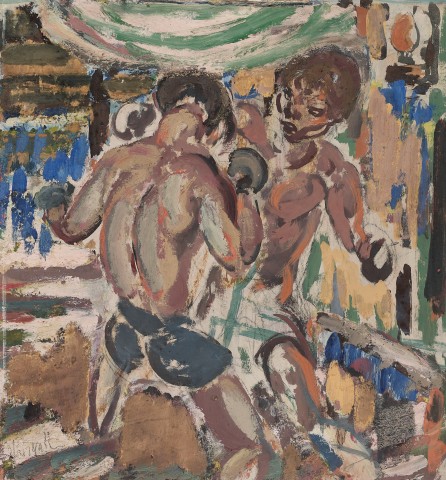LADS BOXING, 1939
IAN FAIRWEATHER
oil and gouache on cardboard
48.0 x 44.5 cm
signed lower left: I Fairweather
Collection of Lina Bryans, Melbourne
Thence by descent
Private collection, Melbourne
Fairweather: a retrospective exhibition, Queensland Art Gallery, Brisbane, 3 June – 4 July 1965; Art Gallery of New South Wales, Sydney, 21 July – 22 August 1965; National Gallery of Victoria, Melbourne, 9 September – 10 October 1965; National Gallery of South Australia, Adelaide, 26 October – 21 November 1965; Western Australian Art Gallery, Perth, 9 December 1965 – 16 January 1966; Tasmanian Museum and Art Gallery, Hobart, 10 February – 13 March 1966, cat. 72 (label attached verso)
Ian Fairweather 1891–1974, National Gallery of Victoria, Melbourne, 25 September – 6 November 1991 (label attached verso)
Bail, M., Ian Fairweather, Bay Books, Sydney, 1981, cat. 53, p. 68, fig. 24 (illus.)
Ian Fairweather was not a creature of comfort. The creative drive that fuelled his art and his intense commitment to living a life devoted to art-making, saw him eschew the material possessions and comfortable physical environments that most people take for granted. During a peripatetic existence in which the Scottish-born artist travelled between England, Canada, China, Bali, Australia, the Philippines and India, he variously lived in a derelict movie theatre, an abandoned railway truck, and a boat wreck washed up on the shore, before settling in 1953 on Bribie Island, off the coast of southern Queensland. Here, for the rest of his life, he lived and worked in a pair of thatched huts built using materials found in the nearby bush, painting by the light of a hurricane lamp.
With little money and no prospects of finding work, Fairweather left the boarding house he had stayed in on his arrival in Cairns in early June 1939, and relocated to a shanty town at Alligator Creek on the outskirts of town. Writing to his friend, the artist William Frater, he said, ‘as soon as I walked into it – I felt at home again – it is like a little bit of the islands – I got a place in an old boathouse along with another hobo – and I just had to start painting again’.1 Postmarked 4 July 1939, this letter to Frater in Melbourne was accompanied by four works – the result of Fairweather’s enthusiastic return to painting in this setting – which he asked him to show ‘to a few friends as soon as you get them’, adding, ‘As for selling them I leave it to you any price at all – I’d be glad of at this moment’.2
The parcel contained two views of Alligator Creek – distinguished as the first of Fairweather’s rare Australian landscape subjects – a portrait of a young local boy and this work, Lads Boxing, 1939.3 Painting familiar subjects that were part of his everyday experience, Fairweather explained that the landscapes were ‘as seen more or less out of the window’ and the boys boxing ‘come up of an evening to train in this old boathouse’.4 The lamp which can be seen in the top right of the image belonged to the artist and was borrowed by the boys for their training. Acknowledging the quid pro quo involved in this exchange, Fairweather wrote, ‘so I took this [image] off them’.5 From a close-up viewpoint, he captures the scene in muted colours which are contrasted with daubs of blue paint, and occasional glimpses of pencil underdrawing beneath. The energetic application of oil paint and gouache echoes the action of the subject, but the focus is clearly the boxers themselves. The features of the rear figure’s face are described in some detail, but it is the muscularity and strength of the boys’ bodies which dominates, communicating both the physicality and intensity of their friendly competition.
Lads Boxing and the three other paintings sent to Frater were bought by Lina Bryans, a noted modern artist who would become a close friend and supporter of Fairweather, establishing what was regarded as the best single collection of his art.6 Notifying Fairweather of the sale and sending £20 by telegraphic transfer care of the Cairns Post Office, Frater added a brief but encouraging note, ‘Very good, keep working’.7
1. Fairweather to William Frater, postmarked 4 July 1939, quoted in Roberts, C. & Thompson, J. (eds.), Ian Fairweather: A Life in Letters, Text Publishing, Melbourne, 2019, p. 104
2. Ibid.
3. Bail, M., Ian Fairweather, Murdoch Books, Sydney, revised edition 2009, p. 59
Fairweather to Frater, op. cit.
4. Fairweather to Frater, op. cit.
5. Ibid.
6. See Forwood, G., Lina Bryans: Rare Modern 1909-2000, The Miegunyah Press, Carlton, 2003, pp. 90-92
7. See Roberts, C. & Thompson, J., op. cit., p. 105
KIRSTY GRANT
